Understanding Corporate Acquisitions in the Digital Era
VerifiedAdded on 2020/05/28
|19
|4427
|128
AI Summary
Porter’s Five Forces Model is an essential tool in business strategy that helps organizations understand the competitive forces shaping their industry. By analyzing five key components—rivalry among existing competitors, barriers to entry or exit, substitutes, bargaining power of buyers, and suppliers—companies can evaluate the intensity of competition and identify opportunities for gaining a strategic edge. This essay will delve into each force, examining its impact on market dynamics and how businesses can leverage this understanding to formulate effective strategies. Through this analysis, students will gain insights into the practical applications of Porter's model in real-world scenarios.
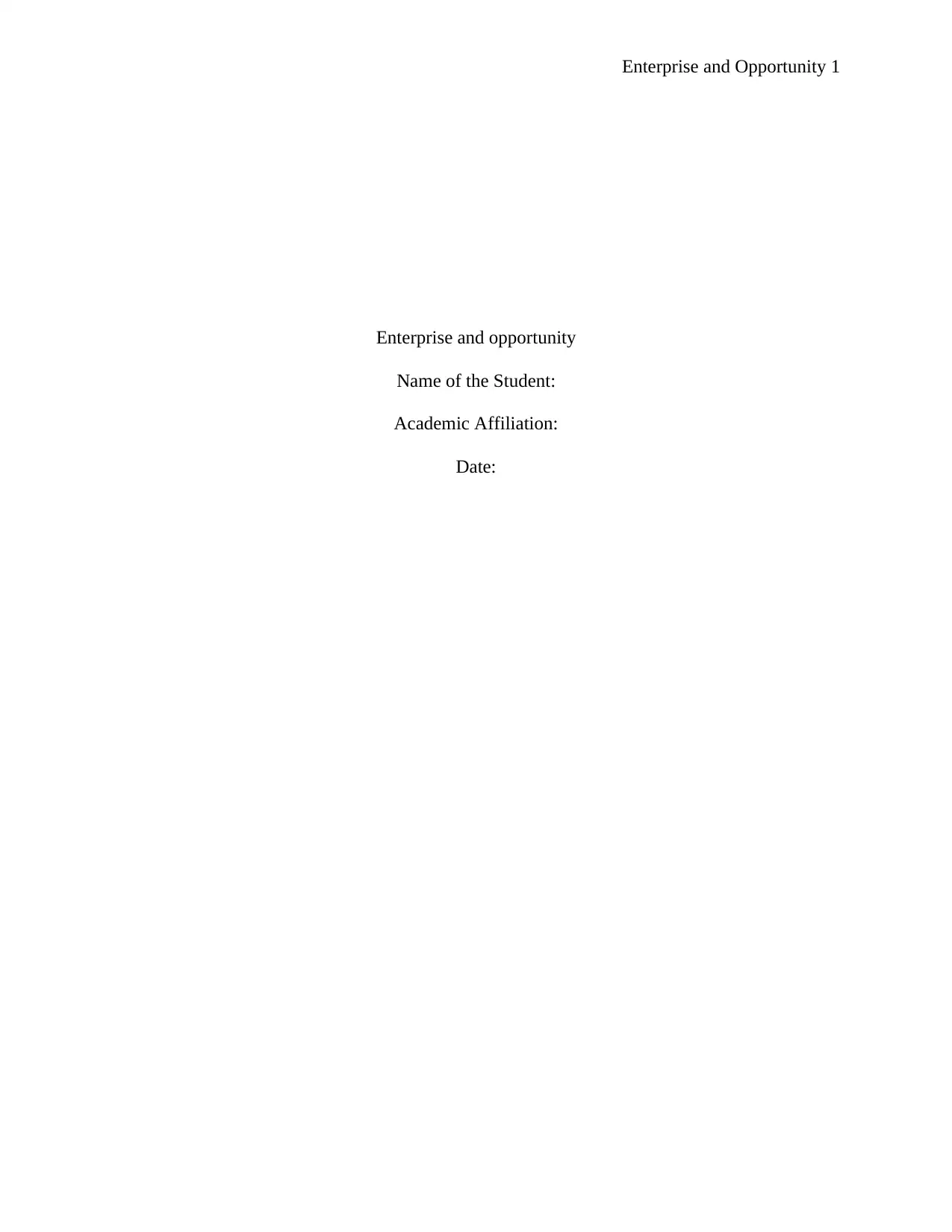
Enterprise and Opportunity 1
Enterprise and opportunity
Name of the Student:
Academic Affiliation:
Date:
Enterprise and opportunity
Name of the Student:
Academic Affiliation:
Date:
Paraphrase This Document
Need a fresh take? Get an instant paraphrase of this document with our AI Paraphraser
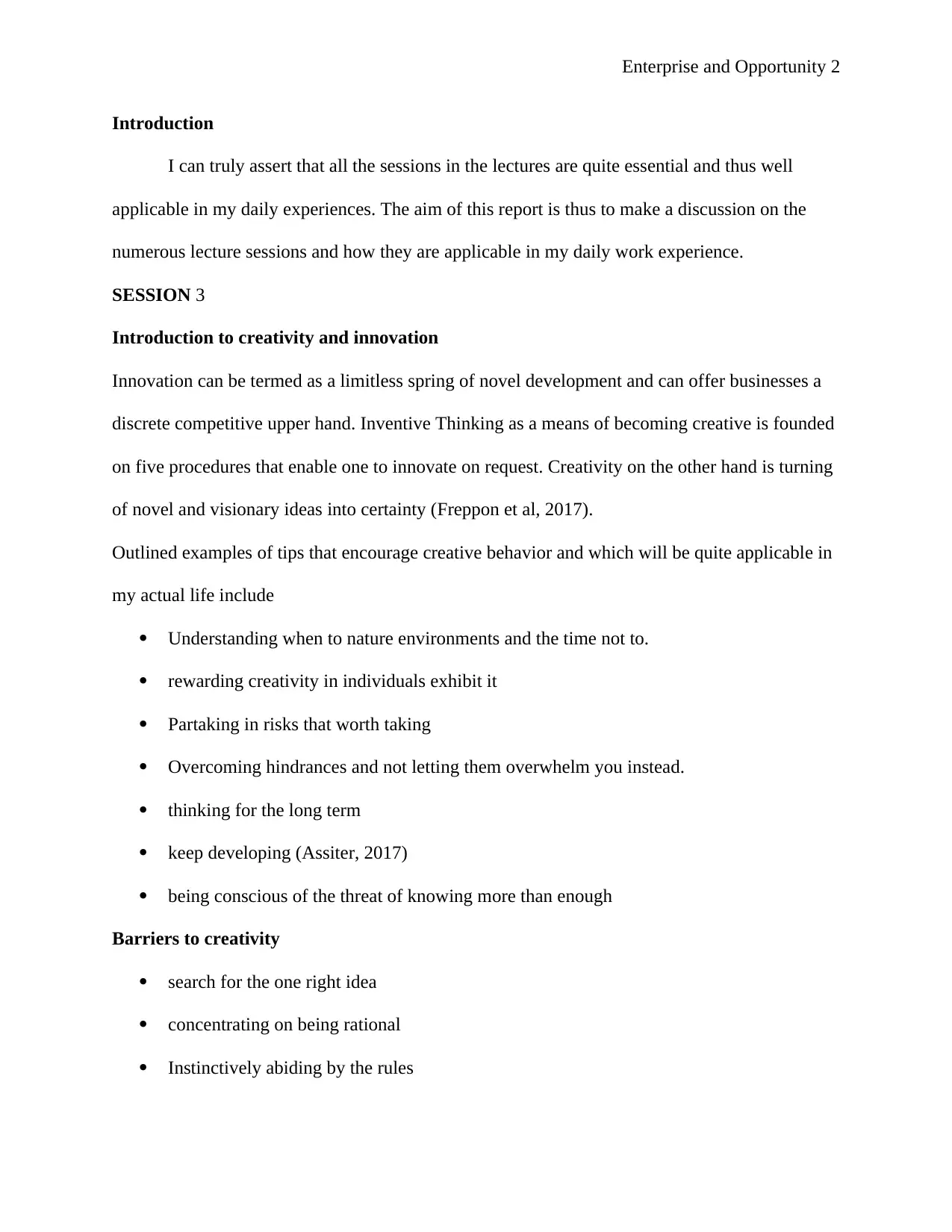
Enterprise and Opportunity 2
Introduction
I can truly assert that all the sessions in the lectures are quite essential and thus well
applicable in my daily experiences. The aim of this report is thus to make a discussion on the
numerous lecture sessions and how they are applicable in my daily work experience.
SESSION 3
Introduction to creativity and innovation
Innovation can be termed as a limitless spring of novel development and can offer businesses a
discrete competitive upper hand. Inventive Thinking as a means of becoming creative is founded
on five procedures that enable one to innovate on request. Creativity on the other hand is turning
of novel and visionary ideas into certainty (Freppon et al, 2017).
Outlined examples of tips that encourage creative behavior and which will be quite applicable in
my actual life include
Understanding when to nature environments and the time not to.
rewarding creativity in individuals exhibit it
Partaking in risks that worth taking
Overcoming hindrances and not letting them overwhelm you instead.
thinking for the long term
keep developing (Assiter, 2017)
being conscious of the threat of knowing more than enough
Barriers to creativity
search for the one right idea
concentrating on being rational
Instinctively abiding by the rules
Introduction
I can truly assert that all the sessions in the lectures are quite essential and thus well
applicable in my daily experiences. The aim of this report is thus to make a discussion on the
numerous lecture sessions and how they are applicable in my daily work experience.
SESSION 3
Introduction to creativity and innovation
Innovation can be termed as a limitless spring of novel development and can offer businesses a
discrete competitive upper hand. Inventive Thinking as a means of becoming creative is founded
on five procedures that enable one to innovate on request. Creativity on the other hand is turning
of novel and visionary ideas into certainty (Freppon et al, 2017).
Outlined examples of tips that encourage creative behavior and which will be quite applicable in
my actual life include
Understanding when to nature environments and the time not to.
rewarding creativity in individuals exhibit it
Partaking in risks that worth taking
Overcoming hindrances and not letting them overwhelm you instead.
thinking for the long term
keep developing (Assiter, 2017)
being conscious of the threat of knowing more than enough
Barriers to creativity
search for the one right idea
concentrating on being rational
Instinctively abiding by the rules
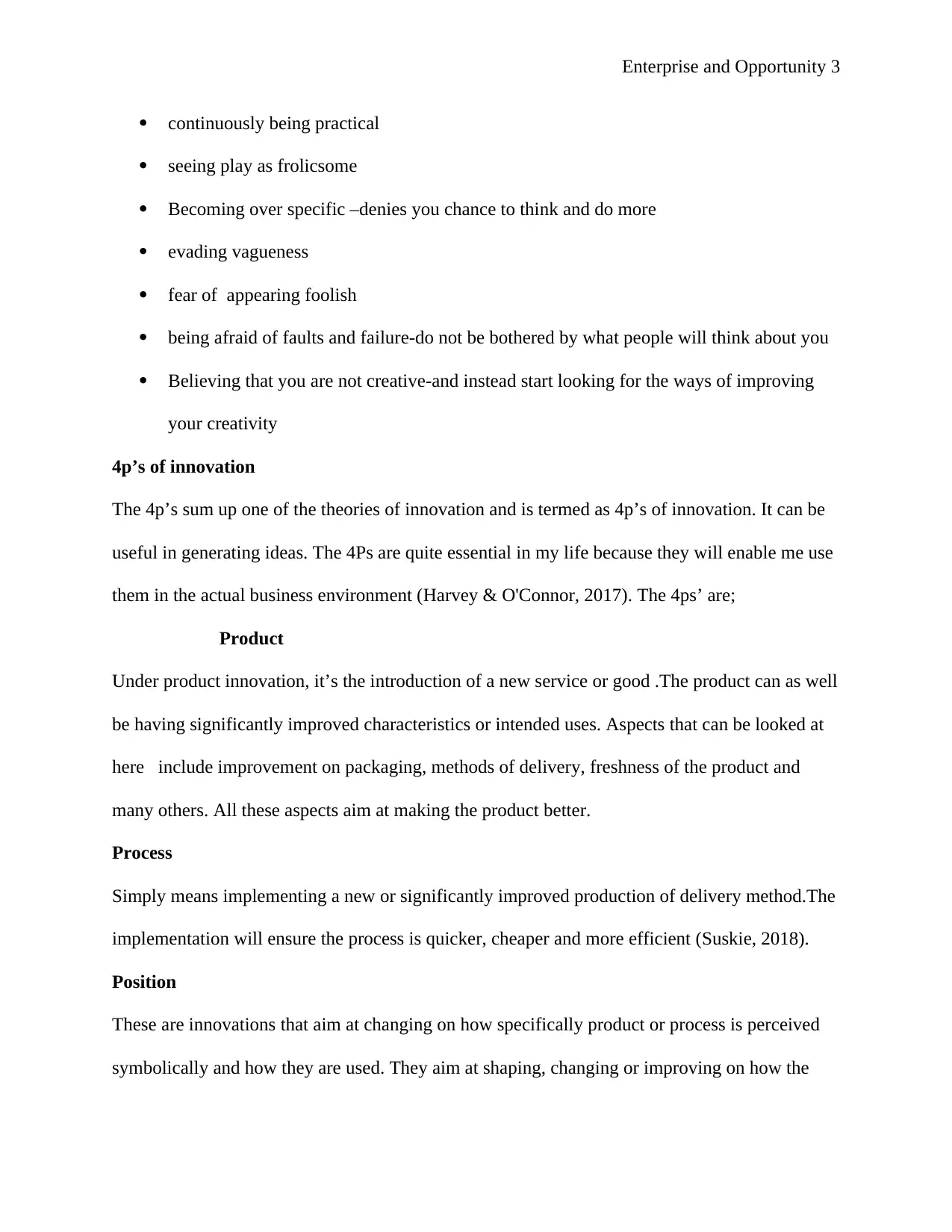
Enterprise and Opportunity 3
continuously being practical
seeing play as frolicsome
Becoming over specific –denies you chance to think and do more
evading vagueness
fear of appearing foolish
being afraid of faults and failure-do not be bothered by what people will think about you
Believing that you are not creative-and instead start looking for the ways of improving
your creativity
4p’s of innovation
The 4p’s sum up one of the theories of innovation and is termed as 4p’s of innovation. It can be
useful in generating ideas. The 4Ps are quite essential in my life because they will enable me use
them in the actual business environment (Harvey & O'Connor, 2017). The 4ps’ are;
Product
Under product innovation, it’s the introduction of a new service or good .The product can as well
be having significantly improved characteristics or intended uses. Aspects that can be looked at
here include improvement on packaging, methods of delivery, freshness of the product and
many others. All these aspects aim at making the product better.
Process
Simply means implementing a new or significantly improved production of delivery method.The
implementation will ensure the process is quicker, cheaper and more efficient (Suskie, 2018).
Position
These are innovations that aim at changing on how specifically product or process is perceived
symbolically and how they are used. They aim at shaping, changing or improving on how the
continuously being practical
seeing play as frolicsome
Becoming over specific –denies you chance to think and do more
evading vagueness
fear of appearing foolish
being afraid of faults and failure-do not be bothered by what people will think about you
Believing that you are not creative-and instead start looking for the ways of improving
your creativity
4p’s of innovation
The 4p’s sum up one of the theories of innovation and is termed as 4p’s of innovation. It can be
useful in generating ideas. The 4Ps are quite essential in my life because they will enable me use
them in the actual business environment (Harvey & O'Connor, 2017). The 4ps’ are;
Product
Under product innovation, it’s the introduction of a new service or good .The product can as well
be having significantly improved characteristics or intended uses. Aspects that can be looked at
here include improvement on packaging, methods of delivery, freshness of the product and
many others. All these aspects aim at making the product better.
Process
Simply means implementing a new or significantly improved production of delivery method.The
implementation will ensure the process is quicker, cheaper and more efficient (Suskie, 2018).
Position
These are innovations that aim at changing on how specifically product or process is perceived
symbolically and how they are used. They aim at shaping, changing or improving on how the
⊘ This is a preview!⊘
Do you want full access?
Subscribe today to unlock all pages.

Trusted by 1+ million students worldwide
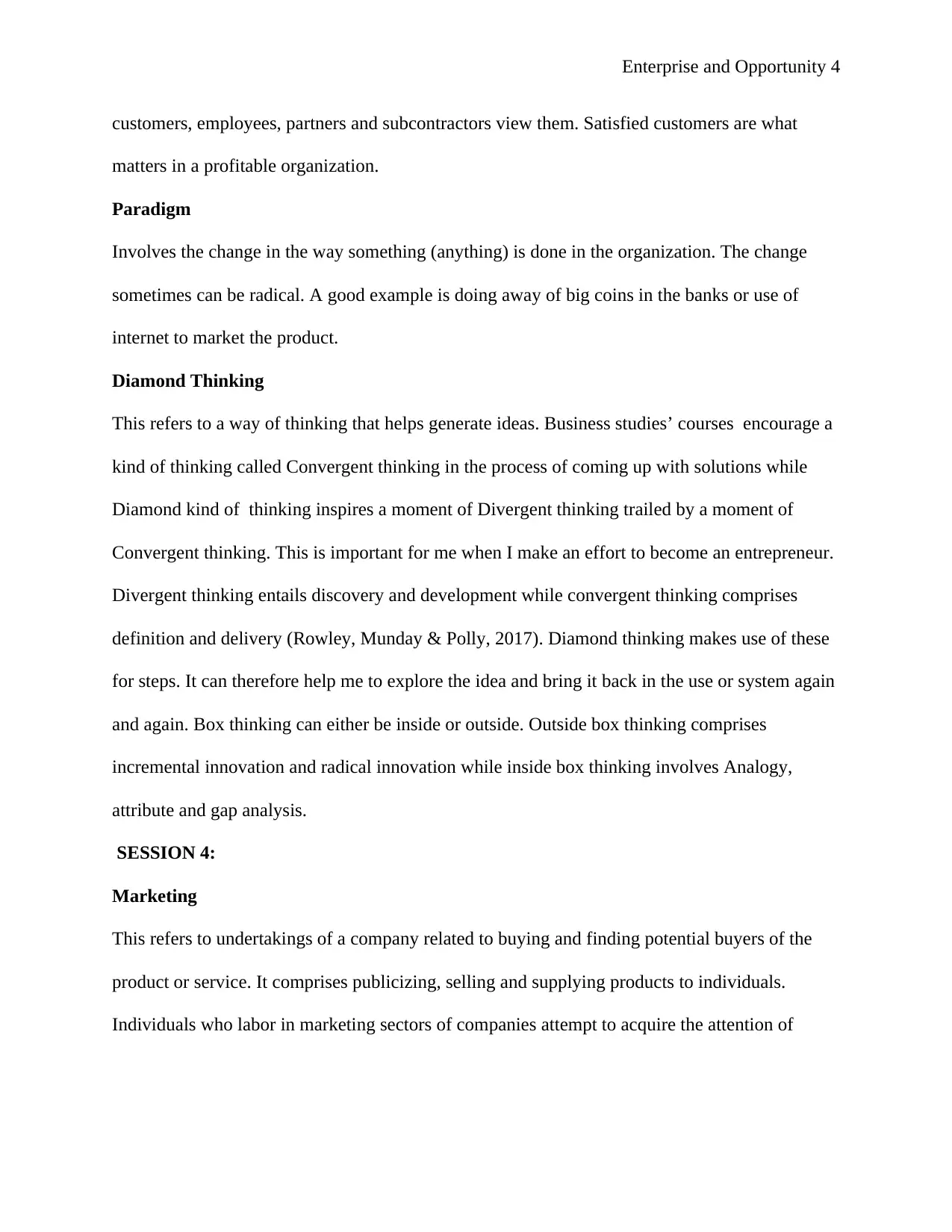
Enterprise and Opportunity 4
customers, employees, partners and subcontractors view them. Satisfied customers are what
matters in a profitable organization.
Paradigm
Involves the change in the way something (anything) is done in the organization. The change
sometimes can be radical. A good example is doing away of big coins in the banks or use of
internet to market the product.
Diamond Thinking
This refers to a way of thinking that helps generate ideas. Business studies’ courses encourage a
kind of thinking called Convergent thinking in the process of coming up with solutions while
Diamond kind of thinking inspires a moment of Divergent thinking trailed by a moment of
Convergent thinking. This is important for me when I make an effort to become an entrepreneur.
Divergent thinking entails discovery and development while convergent thinking comprises
definition and delivery (Rowley, Munday & Polly, 2017). Diamond thinking makes use of these
for steps. It can therefore help me to explore the idea and bring it back in the use or system again
and again. Box thinking can either be inside or outside. Outside box thinking comprises
incremental innovation and radical innovation while inside box thinking involves Analogy,
attribute and gap analysis.
SESSION 4:
Marketing
This refers to undertakings of a company related to buying and finding potential buyers of the
product or service. It comprises publicizing, selling and supplying products to individuals.
Individuals who labor in marketing sectors of companies attempt to acquire the attention of
customers, employees, partners and subcontractors view them. Satisfied customers are what
matters in a profitable organization.
Paradigm
Involves the change in the way something (anything) is done in the organization. The change
sometimes can be radical. A good example is doing away of big coins in the banks or use of
internet to market the product.
Diamond Thinking
This refers to a way of thinking that helps generate ideas. Business studies’ courses encourage a
kind of thinking called Convergent thinking in the process of coming up with solutions while
Diamond kind of thinking inspires a moment of Divergent thinking trailed by a moment of
Convergent thinking. This is important for me when I make an effort to become an entrepreneur.
Divergent thinking entails discovery and development while convergent thinking comprises
definition and delivery (Rowley, Munday & Polly, 2017). Diamond thinking makes use of these
for steps. It can therefore help me to explore the idea and bring it back in the use or system again
and again. Box thinking can either be inside or outside. Outside box thinking comprises
incremental innovation and radical innovation while inside box thinking involves Analogy,
attribute and gap analysis.
SESSION 4:
Marketing
This refers to undertakings of a company related to buying and finding potential buyers of the
product or service. It comprises publicizing, selling and supplying products to individuals.
Individuals who labor in marketing sectors of companies attempt to acquire the attention of
Paraphrase This Document
Need a fresh take? Get an instant paraphrase of this document with our AI Paraphraser
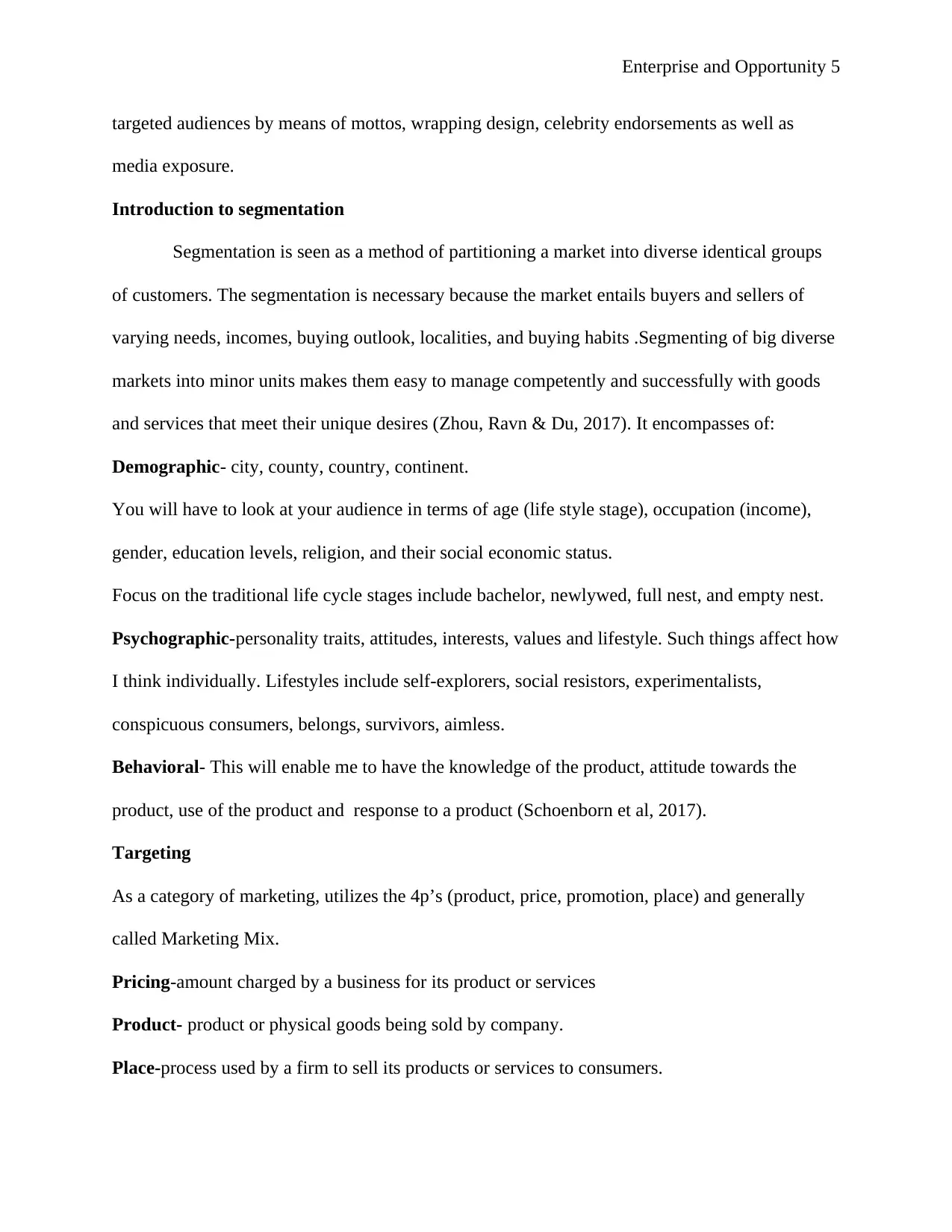
Enterprise and Opportunity 5
targeted audiences by means of mottos, wrapping design, celebrity endorsements as well as
media exposure.
Introduction to segmentation
Segmentation is seen as a method of partitioning a market into diverse identical groups
of customers. The segmentation is necessary because the market entails buyers and sellers of
varying needs, incomes, buying outlook, localities, and buying habits .Segmenting of big diverse
markets into minor units makes them easy to manage competently and successfully with goods
and services that meet their unique desires (Zhou, Ravn & Du, 2017). It encompasses of:
Demographic- city, county, country, continent.
You will have to look at your audience in terms of age (life style stage), occupation (income),
gender, education levels, religion, and their social economic status.
Focus on the traditional life cycle stages include bachelor, newlywed, full nest, and empty nest.
Psychographic-personality traits, attitudes, interests, values and lifestyle. Such things affect how
I think individually. Lifestyles include self-explorers, social resistors, experimentalists,
conspicuous consumers, belongs, survivors, aimless.
Behavioral- This will enable me to have the knowledge of the product, attitude towards the
product, use of the product and response to a product (Schoenborn et al, 2017).
Targeting
As a category of marketing, utilizes the 4p’s (product, price, promotion, place) and generally
called Marketing Mix.
Pricing-amount charged by a business for its product or services
Product- product or physical goods being sold by company.
Place-process used by a firm to sell its products or services to consumers.
targeted audiences by means of mottos, wrapping design, celebrity endorsements as well as
media exposure.
Introduction to segmentation
Segmentation is seen as a method of partitioning a market into diverse identical groups
of customers. The segmentation is necessary because the market entails buyers and sellers of
varying needs, incomes, buying outlook, localities, and buying habits .Segmenting of big diverse
markets into minor units makes them easy to manage competently and successfully with goods
and services that meet their unique desires (Zhou, Ravn & Du, 2017). It encompasses of:
Demographic- city, county, country, continent.
You will have to look at your audience in terms of age (life style stage), occupation (income),
gender, education levels, religion, and their social economic status.
Focus on the traditional life cycle stages include bachelor, newlywed, full nest, and empty nest.
Psychographic-personality traits, attitudes, interests, values and lifestyle. Such things affect how
I think individually. Lifestyles include self-explorers, social resistors, experimentalists,
conspicuous consumers, belongs, survivors, aimless.
Behavioral- This will enable me to have the knowledge of the product, attitude towards the
product, use of the product and response to a product (Schoenborn et al, 2017).
Targeting
As a category of marketing, utilizes the 4p’s (product, price, promotion, place) and generally
called Marketing Mix.
Pricing-amount charged by a business for its product or services
Product- product or physical goods being sold by company.
Place-process used by a firm to sell its products or services to consumers.
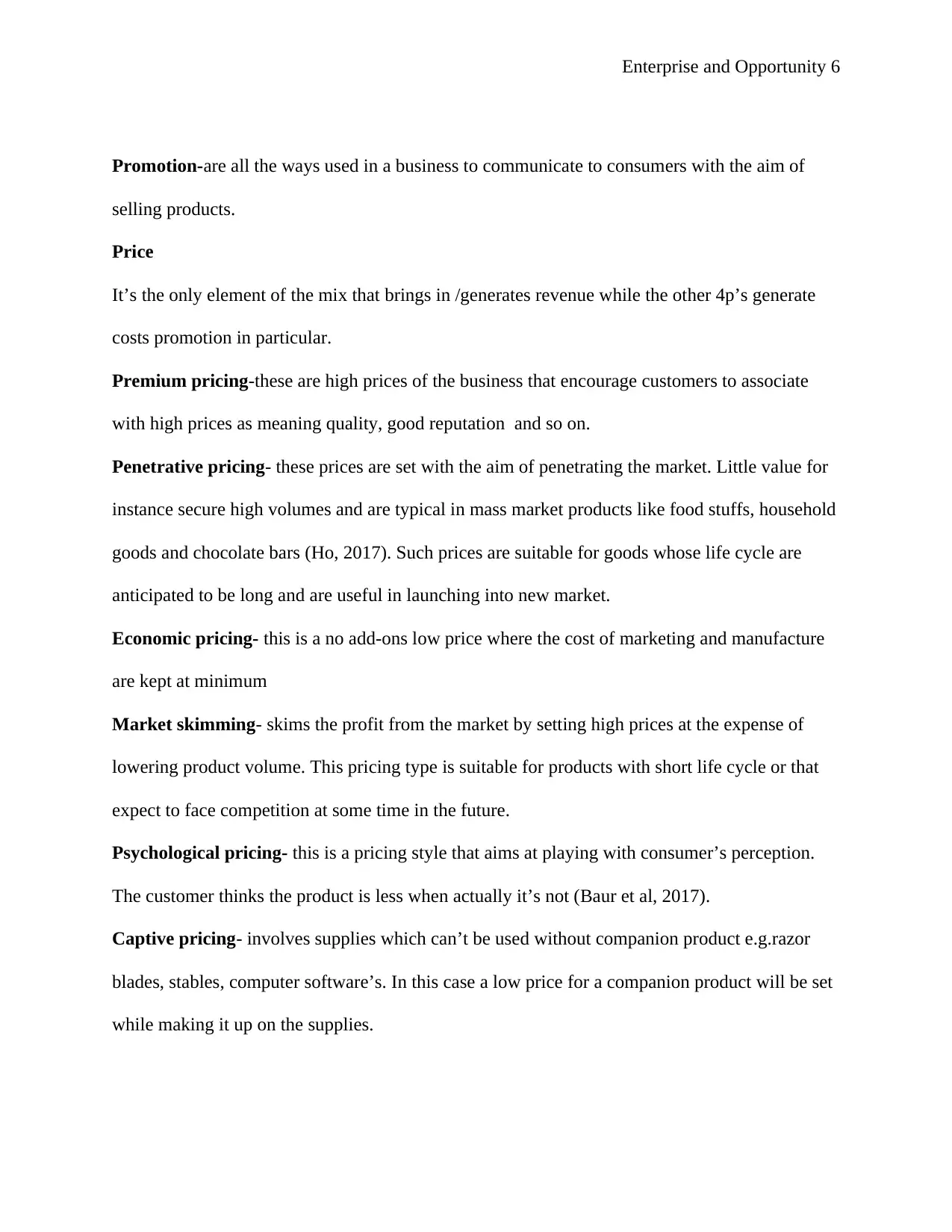
Enterprise and Opportunity 6
Promotion-are all the ways used in a business to communicate to consumers with the aim of
selling products.
Price
It’s the only element of the mix that brings in /generates revenue while the other 4p’s generate
costs promotion in particular.
Premium pricing-these are high prices of the business that encourage customers to associate
with high prices as meaning quality, good reputation and so on.
Penetrative pricing- these prices are set with the aim of penetrating the market. Little value for
instance secure high volumes and are typical in mass market products like food stuffs, household
goods and chocolate bars (Ho, 2017). Such prices are suitable for goods whose life cycle are
anticipated to be long and are useful in launching into new market.
Economic pricing- this is a no add-ons low price where the cost of marketing and manufacture
are kept at minimum
Market skimming- skims the profit from the market by setting high prices at the expense of
lowering product volume. This pricing type is suitable for products with short life cycle or that
expect to face competition at some time in the future.
Psychological pricing- this is a pricing style that aims at playing with consumer’s perception.
The customer thinks the product is less when actually it’s not (Baur et al, 2017).
Captive pricing- involves supplies which can’t be used without companion product e.g.razor
blades, stables, computer software’s. In this case a low price for a companion product will be set
while making it up on the supplies.
Promotion-are all the ways used in a business to communicate to consumers with the aim of
selling products.
Price
It’s the only element of the mix that brings in /generates revenue while the other 4p’s generate
costs promotion in particular.
Premium pricing-these are high prices of the business that encourage customers to associate
with high prices as meaning quality, good reputation and so on.
Penetrative pricing- these prices are set with the aim of penetrating the market. Little value for
instance secure high volumes and are typical in mass market products like food stuffs, household
goods and chocolate bars (Ho, 2017). Such prices are suitable for goods whose life cycle are
anticipated to be long and are useful in launching into new market.
Economic pricing- this is a no add-ons low price where the cost of marketing and manufacture
are kept at minimum
Market skimming- skims the profit from the market by setting high prices at the expense of
lowering product volume. This pricing type is suitable for products with short life cycle or that
expect to face competition at some time in the future.
Psychological pricing- this is a pricing style that aims at playing with consumer’s perception.
The customer thinks the product is less when actually it’s not (Baur et al, 2017).
Captive pricing- involves supplies which can’t be used without companion product e.g.razor
blades, stables, computer software’s. In this case a low price for a companion product will be set
while making it up on the supplies.
⊘ This is a preview!⊘
Do you want full access?
Subscribe today to unlock all pages.

Trusted by 1+ million students worldwide
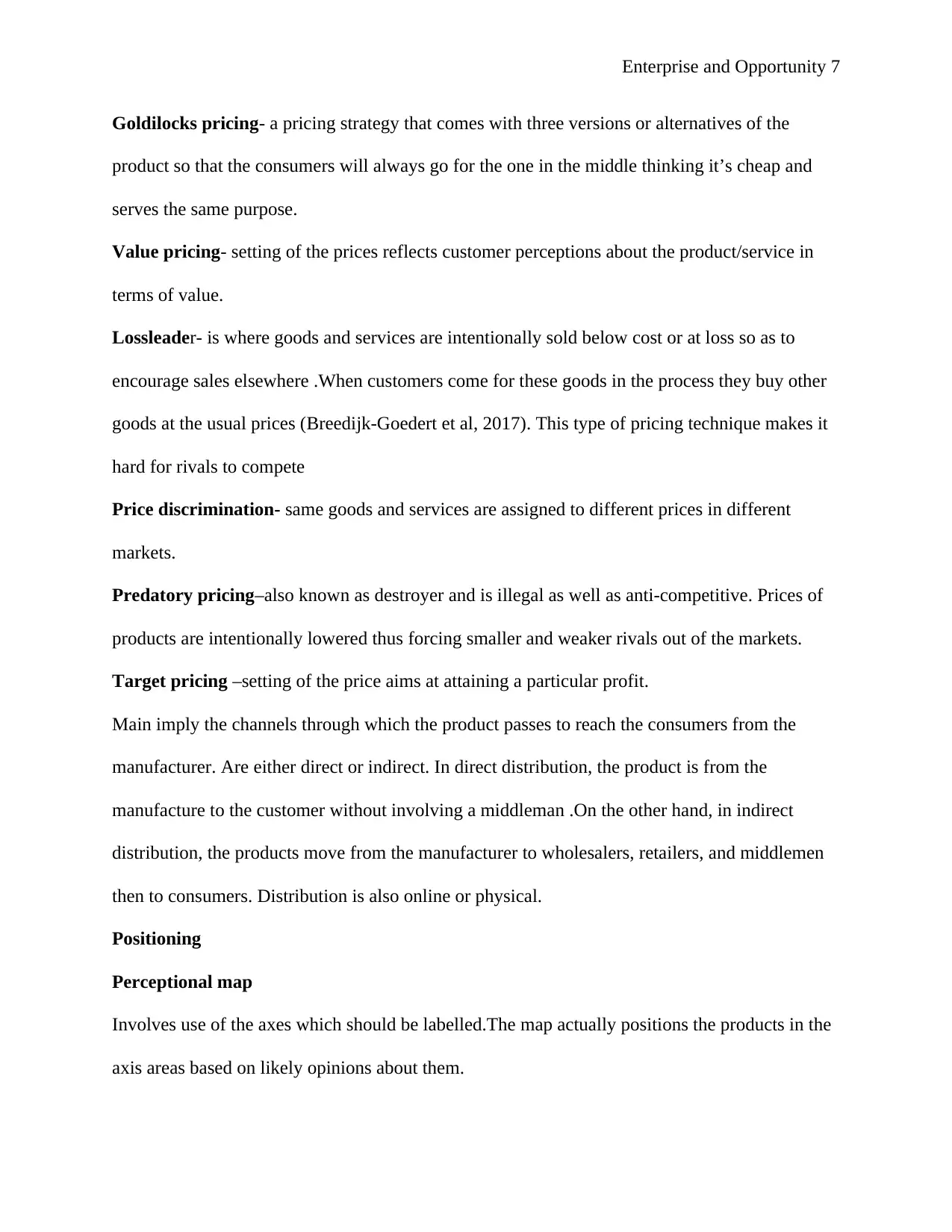
Enterprise and Opportunity 7
Goldilocks pricing- a pricing strategy that comes with three versions or alternatives of the
product so that the consumers will always go for the one in the middle thinking it’s cheap and
serves the same purpose.
Value pricing- setting of the prices reflects customer perceptions about the product/service in
terms of value.
Lossleader- is where goods and services are intentionally sold below cost or at loss so as to
encourage sales elsewhere .When customers come for these goods in the process they buy other
goods at the usual prices (Breedijk-Goedert et al, 2017). This type of pricing technique makes it
hard for rivals to compete
Price discrimination- same goods and services are assigned to different prices in different
markets.
Predatory pricing–also known as destroyer and is illegal as well as anti-competitive. Prices of
products are intentionally lowered thus forcing smaller and weaker rivals out of the markets.
Target pricing –setting of the price aims at attaining a particular profit.
Main imply the channels through which the product passes to reach the consumers from the
manufacturer. Are either direct or indirect. In direct distribution, the product is from the
manufacture to the customer without involving a middleman .On the other hand, in indirect
distribution, the products move from the manufacturer to wholesalers, retailers, and middlemen
then to consumers. Distribution is also online or physical.
Positioning
Perceptional map
Involves use of the axes which should be labelled.The map actually positions the products in the
axis areas based on likely opinions about them.
Goldilocks pricing- a pricing strategy that comes with three versions or alternatives of the
product so that the consumers will always go for the one in the middle thinking it’s cheap and
serves the same purpose.
Value pricing- setting of the prices reflects customer perceptions about the product/service in
terms of value.
Lossleader- is where goods and services are intentionally sold below cost or at loss so as to
encourage sales elsewhere .When customers come for these goods in the process they buy other
goods at the usual prices (Breedijk-Goedert et al, 2017). This type of pricing technique makes it
hard for rivals to compete
Price discrimination- same goods and services are assigned to different prices in different
markets.
Predatory pricing–also known as destroyer and is illegal as well as anti-competitive. Prices of
products are intentionally lowered thus forcing smaller and weaker rivals out of the markets.
Target pricing –setting of the price aims at attaining a particular profit.
Main imply the channels through which the product passes to reach the consumers from the
manufacturer. Are either direct or indirect. In direct distribution, the product is from the
manufacture to the customer without involving a middleman .On the other hand, in indirect
distribution, the products move from the manufacturer to wholesalers, retailers, and middlemen
then to consumers. Distribution is also online or physical.
Positioning
Perceptional map
Involves use of the axes which should be labelled.The map actually positions the products in the
axis areas based on likely opinions about them.
Paraphrase This Document
Need a fresh take? Get an instant paraphrase of this document with our AI Paraphraser
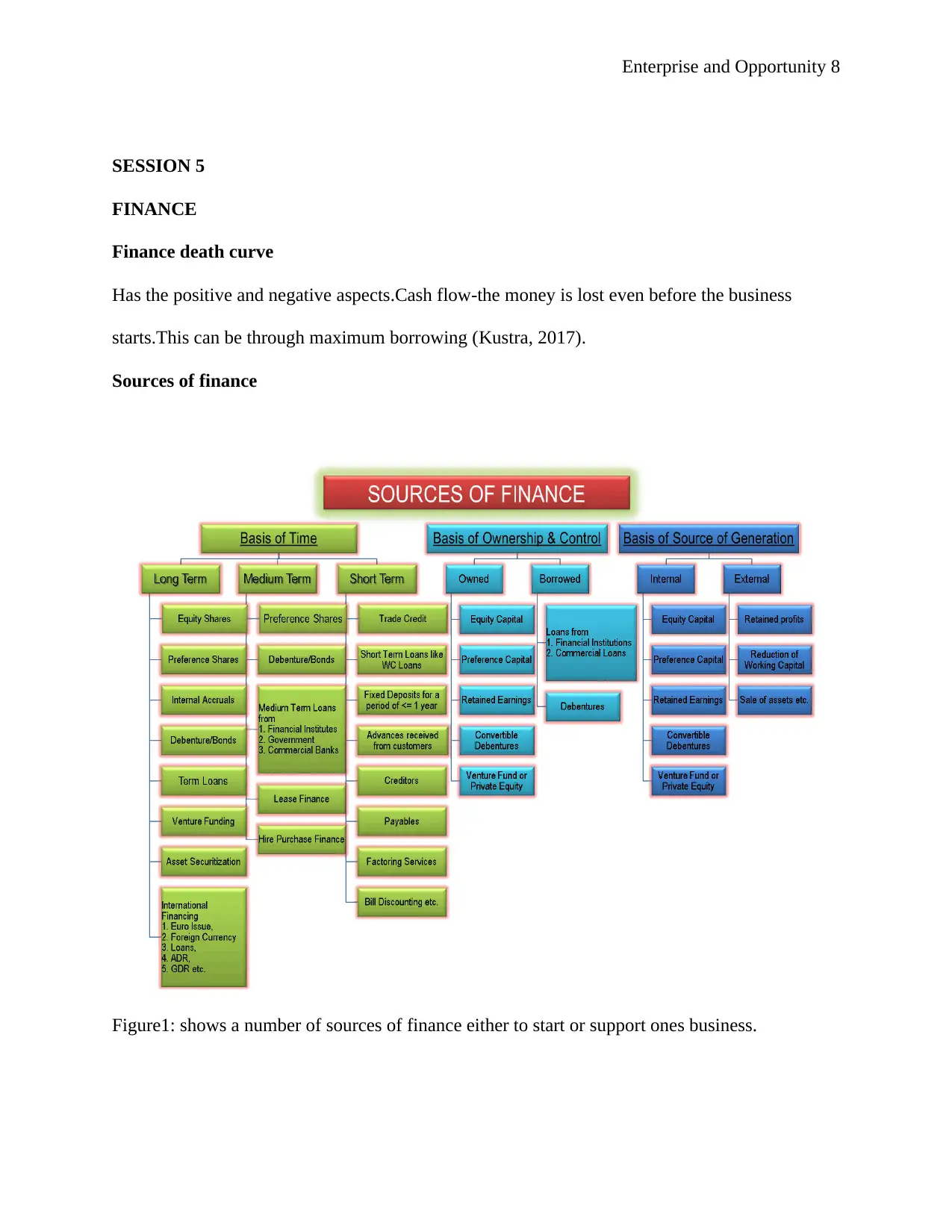
Enterprise and Opportunity 8
SESSION 5
FINANCE
Finance death curve
Has the positive and negative aspects.Cash flow-the money is lost even before the business
starts.This can be through maximum borrowing (Kustra, 2017).
Sources of finance
Figure1: shows a number of sources of finance either to start or support ones business.
SESSION 5
FINANCE
Finance death curve
Has the positive and negative aspects.Cash flow-the money is lost even before the business
starts.This can be through maximum borrowing (Kustra, 2017).
Sources of finance
Figure1: shows a number of sources of finance either to start or support ones business.
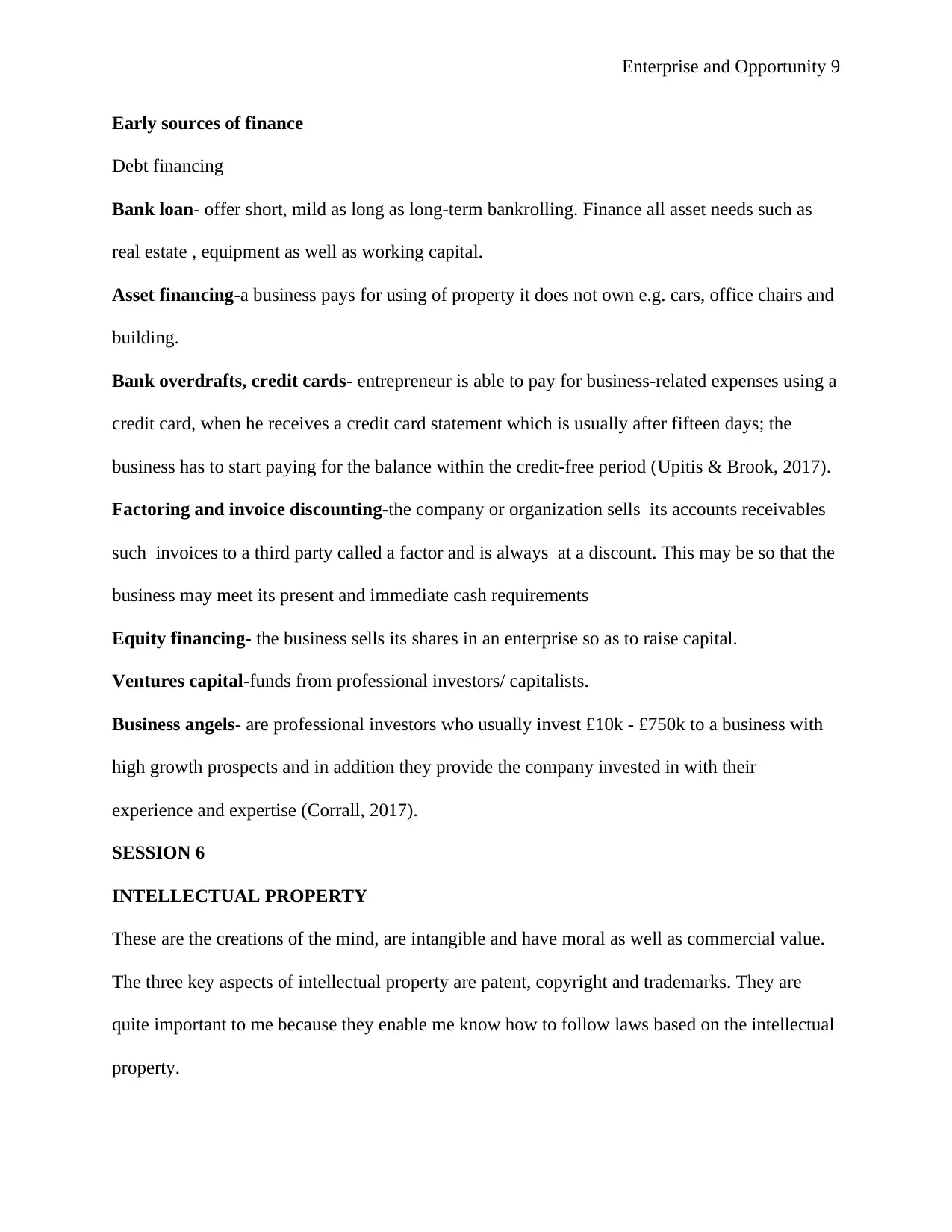
Enterprise and Opportunity 9
Early sources of finance
Debt financing
Bank loan- offer short, mild as long as long-term bankrolling. Finance all asset needs such as
real estate , equipment as well as working capital.
Asset financing-a business pays for using of property it does not own e.g. cars, office chairs and
building.
Bank overdrafts, credit cards- entrepreneur is able to pay for business-related expenses using a
credit card, when he receives a credit card statement which is usually after fifteen days; the
business has to start paying for the balance within the credit-free period (Upitis & Brook, 2017).
Factoring and invoice discounting-the company or organization sells its accounts receivables
such invoices to a third party called a factor and is always at a discount. This may be so that the
business may meet its present and immediate cash requirements
Equity financing- the business sells its shares in an enterprise so as to raise capital.
Ventures capital-funds from professional investors/ capitalists.
Business angels- are professional investors who usually invest £10k - £750k to a business with
high growth prospects and in addition they provide the company invested in with their
experience and expertise (Corrall, 2017).
SESSION 6
INTELLECTUAL PROPERTY
These are the creations of the mind, are intangible and have moral as well as commercial value.
The three key aspects of intellectual property are patent, copyright and trademarks. They are
quite important to me because they enable me know how to follow laws based on the intellectual
property.
Early sources of finance
Debt financing
Bank loan- offer short, mild as long as long-term bankrolling. Finance all asset needs such as
real estate , equipment as well as working capital.
Asset financing-a business pays for using of property it does not own e.g. cars, office chairs and
building.
Bank overdrafts, credit cards- entrepreneur is able to pay for business-related expenses using a
credit card, when he receives a credit card statement which is usually after fifteen days; the
business has to start paying for the balance within the credit-free period (Upitis & Brook, 2017).
Factoring and invoice discounting-the company or organization sells its accounts receivables
such invoices to a third party called a factor and is always at a discount. This may be so that the
business may meet its present and immediate cash requirements
Equity financing- the business sells its shares in an enterprise so as to raise capital.
Ventures capital-funds from professional investors/ capitalists.
Business angels- are professional investors who usually invest £10k - £750k to a business with
high growth prospects and in addition they provide the company invested in with their
experience and expertise (Corrall, 2017).
SESSION 6
INTELLECTUAL PROPERTY
These are the creations of the mind, are intangible and have moral as well as commercial value.
The three key aspects of intellectual property are patent, copyright and trademarks. They are
quite important to me because they enable me know how to follow laws based on the intellectual
property.
⊘ This is a preview!⊘
Do you want full access?
Subscribe today to unlock all pages.

Trusted by 1+ million students worldwide
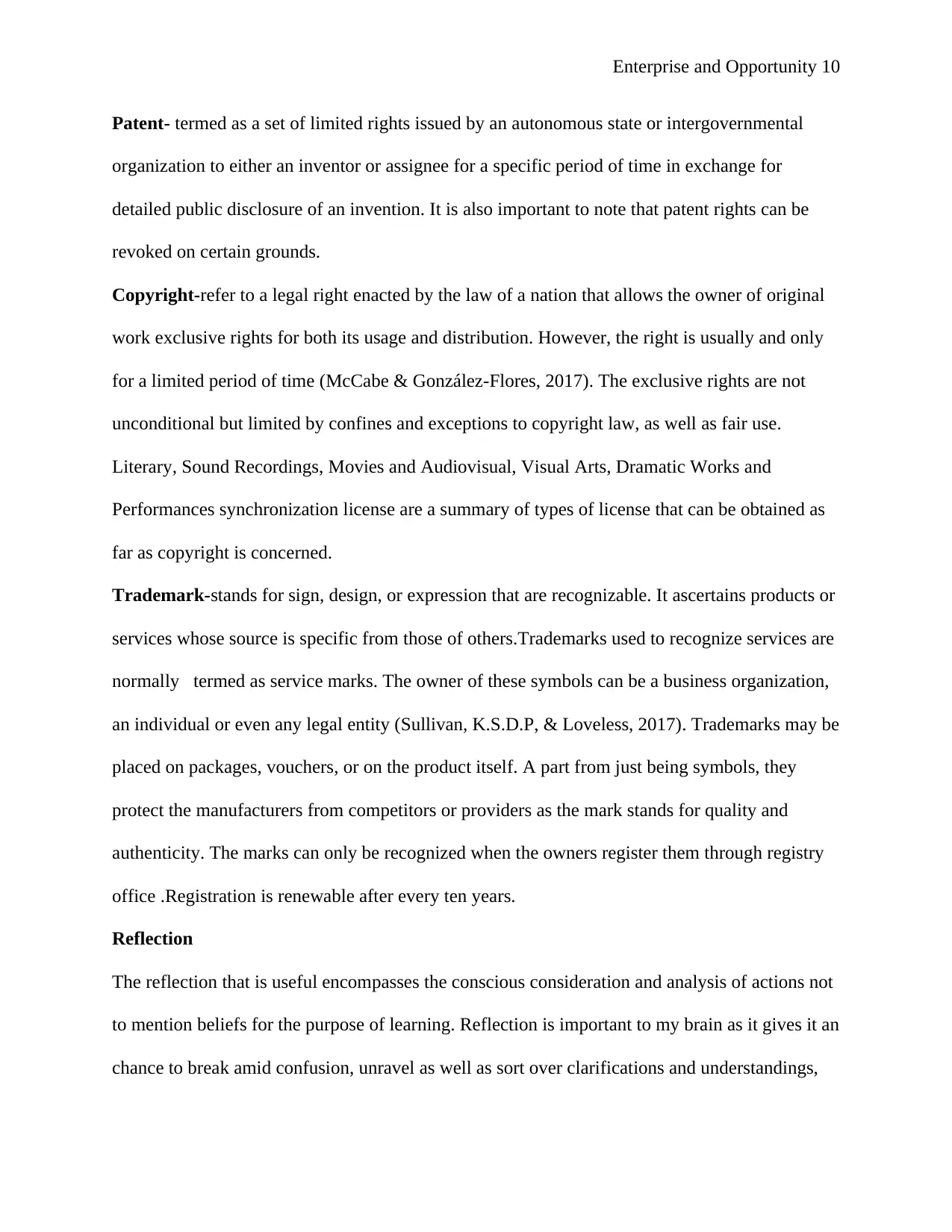
Enterprise and Opportunity 10
Patent- termed as a set of limited rights issued by an autonomous state or intergovernmental
organization to either an inventor or assignee for a specific period of time in exchange for
detailed public disclosure of an invention. It is also important to note that patent rights can be
revoked on certain grounds.
Copyright-refer to a legal right enacted by the law of a nation that allows the owner of original
work exclusive rights for both its usage and distribution. However, the right is usually and only
for a limited period of time (McCabe & González-Flores, 2017). The exclusive rights are not
unconditional but limited by confines and exceptions to copyright law, as well as fair use.
Literary, Sound Recordings, Movies and Audiovisual, Visual Arts, Dramatic Works and
Performances synchronization license are a summary of types of license that can be obtained as
far as copyright is concerned.
Trademark-stands for sign, design, or expression that are recognizable. It ascertains products or
services whose source is specific from those of others.Trademarks used to recognize services are
normally termed as service marks. The owner of these symbols can be a business organization,
an individual or even any legal entity (Sullivan, K.S.D.P, & Loveless, 2017). Trademarks may be
placed on packages, vouchers, or on the product itself. A part from just being symbols, they
protect the manufacturers from competitors or providers as the mark stands for quality and
authenticity. The marks can only be recognized when the owners register them through registry
office .Registration is renewable after every ten years.
Reflection
The reflection that is useful encompasses the conscious consideration and analysis of actions not
to mention beliefs for the purpose of learning. Reflection is important to my brain as it gives it an
chance to break amid confusion, unravel as well as sort over clarifications and understandings,
Patent- termed as a set of limited rights issued by an autonomous state or intergovernmental
organization to either an inventor or assignee for a specific period of time in exchange for
detailed public disclosure of an invention. It is also important to note that patent rights can be
revoked on certain grounds.
Copyright-refer to a legal right enacted by the law of a nation that allows the owner of original
work exclusive rights for both its usage and distribution. However, the right is usually and only
for a limited period of time (McCabe & González-Flores, 2017). The exclusive rights are not
unconditional but limited by confines and exceptions to copyright law, as well as fair use.
Literary, Sound Recordings, Movies and Audiovisual, Visual Arts, Dramatic Works and
Performances synchronization license are a summary of types of license that can be obtained as
far as copyright is concerned.
Trademark-stands for sign, design, or expression that are recognizable. It ascertains products or
services whose source is specific from those of others.Trademarks used to recognize services are
normally termed as service marks. The owner of these symbols can be a business organization,
an individual or even any legal entity (Sullivan, K.S.D.P, & Loveless, 2017). Trademarks may be
placed on packages, vouchers, or on the product itself. A part from just being symbols, they
protect the manufacturers from competitors or providers as the mark stands for quality and
authenticity. The marks can only be recognized when the owners register them through registry
office .Registration is renewable after every ten years.
Reflection
The reflection that is useful encompasses the conscious consideration and analysis of actions not
to mention beliefs for the purpose of learning. Reflection is important to my brain as it gives it an
chance to break amid confusion, unravel as well as sort over clarifications and understandings,
Paraphrase This Document
Need a fresh take? Get an instant paraphrase of this document with our AI Paraphraser
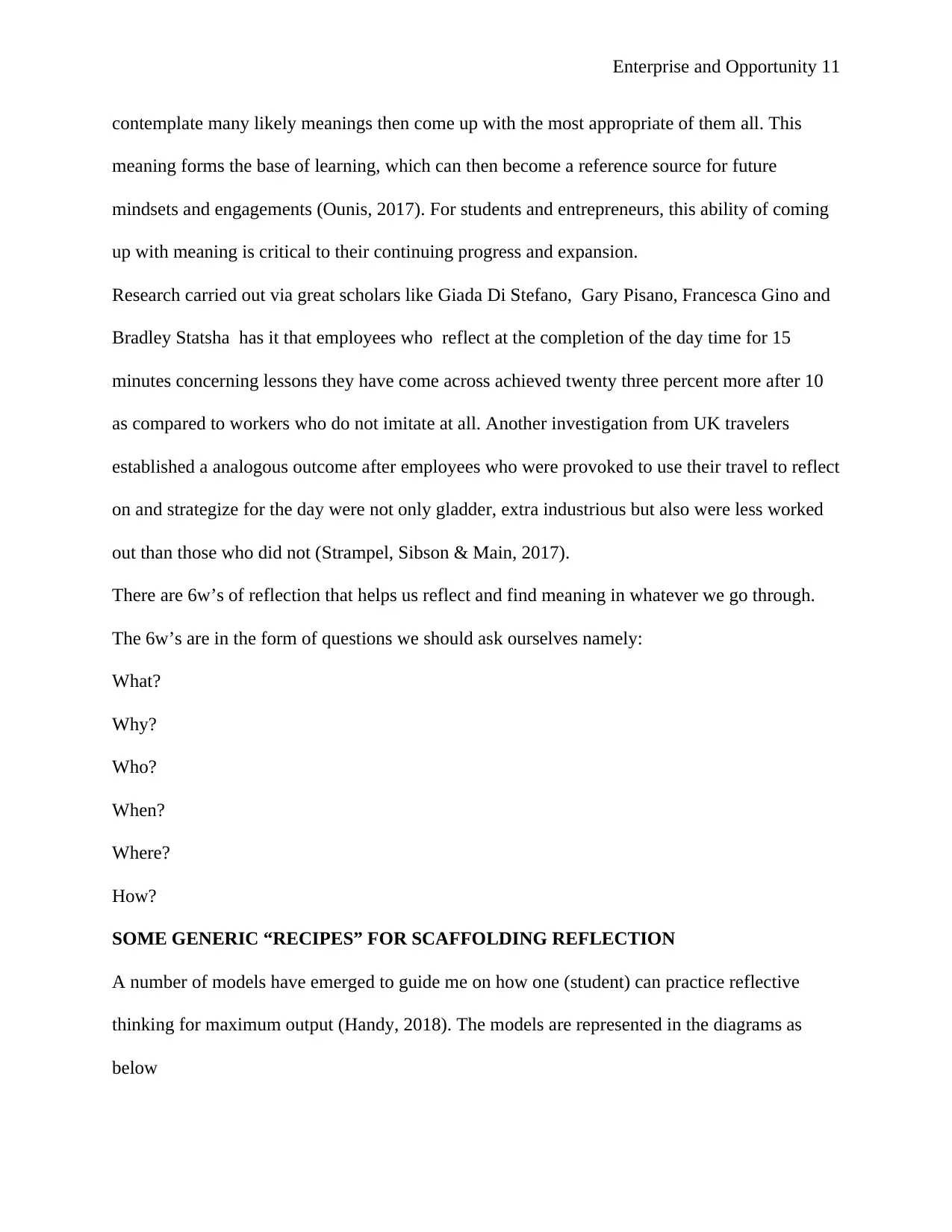
Enterprise and Opportunity 11
contemplate many likely meanings then come up with the most appropriate of them all. This
meaning forms the base of learning, which can then become a reference source for future
mindsets and engagements (Ounis, 2017). For students and entrepreneurs, this ability of coming
up with meaning is critical to their continuing progress and expansion.
Research carried out via great scholars like Giada Di Stefano, Gary Pisano, Francesca Gino and
Bradley Statsha has it that employees who reflect at the completion of the day time for 15
minutes concerning lessons they have come across achieved twenty three percent more after 10
as compared to workers who do not imitate at all. Another investigation from UK travelers
established a analogous outcome after employees who were provoked to use their travel to reflect
on and strategize for the day were not only gladder, extra industrious but also were less worked
out than those who did not (Strampel, Sibson & Main, 2017).
There are 6w’s of reflection that helps us reflect and find meaning in whatever we go through.
The 6w’s are in the form of questions we should ask ourselves namely:
What?
Why?
Who?
When?
Where?
How?
SOME GENERIC “RECIPES” FOR SCAFFOLDING REFLECTION
A number of models have emerged to guide me on how one (student) can practice reflective
thinking for maximum output (Handy, 2018). The models are represented in the diagrams as
below
contemplate many likely meanings then come up with the most appropriate of them all. This
meaning forms the base of learning, which can then become a reference source for future
mindsets and engagements (Ounis, 2017). For students and entrepreneurs, this ability of coming
up with meaning is critical to their continuing progress and expansion.
Research carried out via great scholars like Giada Di Stefano, Gary Pisano, Francesca Gino and
Bradley Statsha has it that employees who reflect at the completion of the day time for 15
minutes concerning lessons they have come across achieved twenty three percent more after 10
as compared to workers who do not imitate at all. Another investigation from UK travelers
established a analogous outcome after employees who were provoked to use their travel to reflect
on and strategize for the day were not only gladder, extra industrious but also were less worked
out than those who did not (Strampel, Sibson & Main, 2017).
There are 6w’s of reflection that helps us reflect and find meaning in whatever we go through.
The 6w’s are in the form of questions we should ask ourselves namely:
What?
Why?
Who?
When?
Where?
How?
SOME GENERIC “RECIPES” FOR SCAFFOLDING REFLECTION
A number of models have emerged to guide me on how one (student) can practice reflective
thinking for maximum output (Handy, 2018). The models are represented in the diagrams as
below
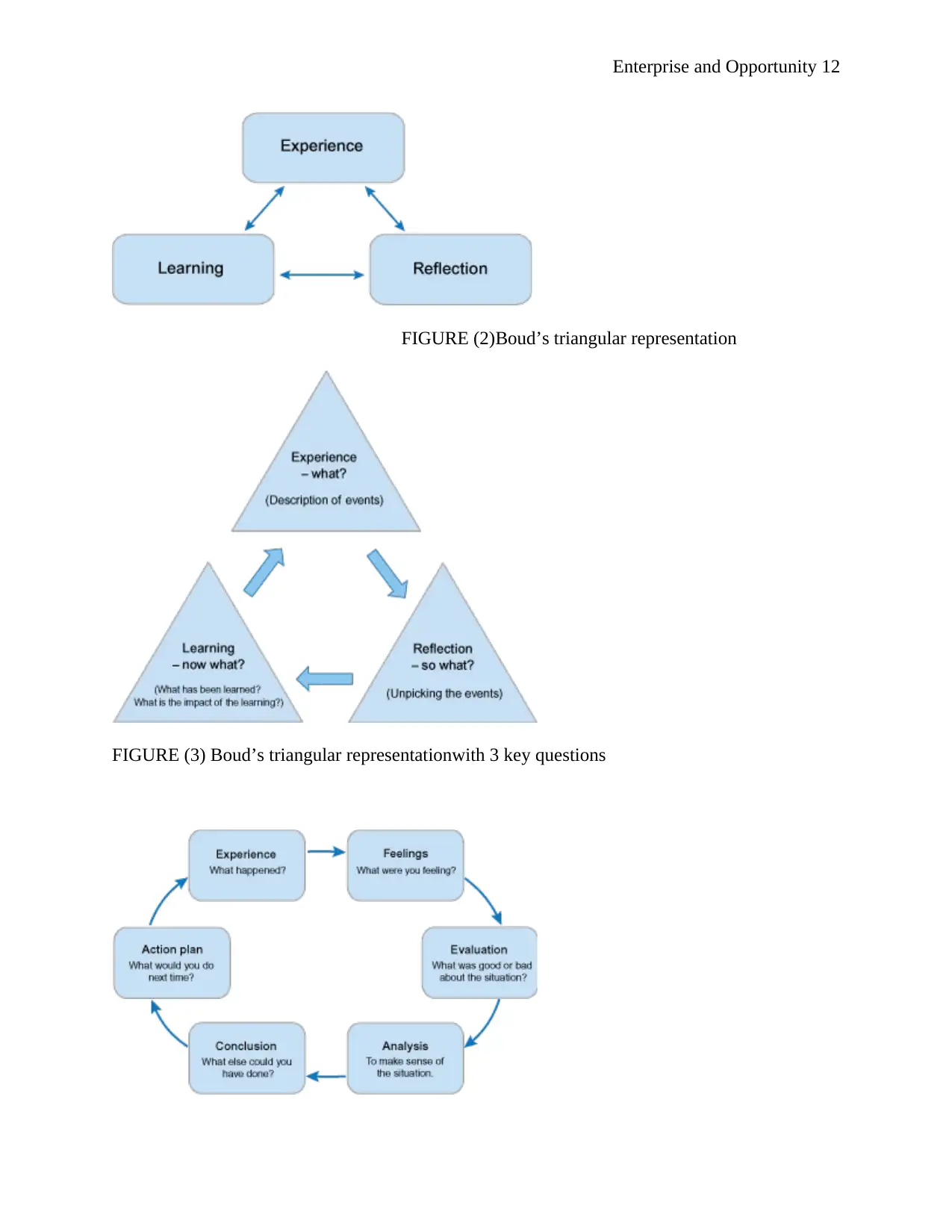
Enterprise and Opportunity 12
FIGURE (2)Boud’s triangular representation
FIGURE (3) Boud’s triangular representationwith 3 key questions
FIGURE (2)Boud’s triangular representation
FIGURE (3) Boud’s triangular representationwith 3 key questions
⊘ This is a preview!⊘
Do you want full access?
Subscribe today to unlock all pages.

Trusted by 1+ million students worldwide
1 out of 19
Related Documents
Your All-in-One AI-Powered Toolkit for Academic Success.
+13062052269
info@desklib.com
Available 24*7 on WhatsApp / Email
![[object Object]](/_next/static/media/star-bottom.7253800d.svg)
Unlock your academic potential
Copyright © 2020–2025 A2Z Services. All Rights Reserved. Developed and managed by ZUCOL.



